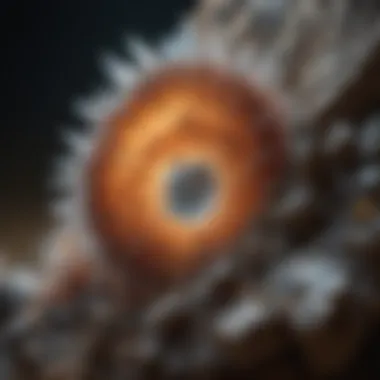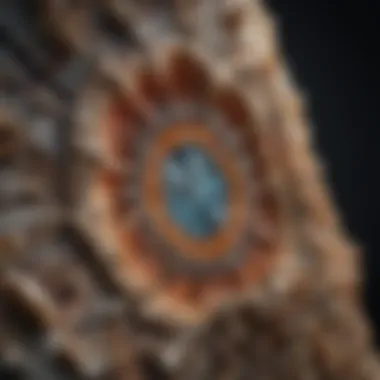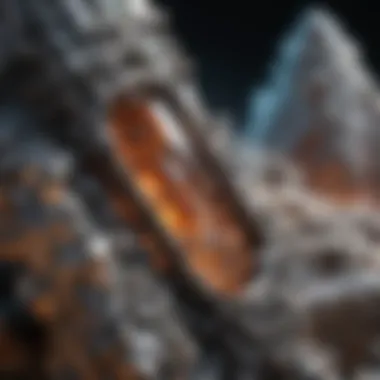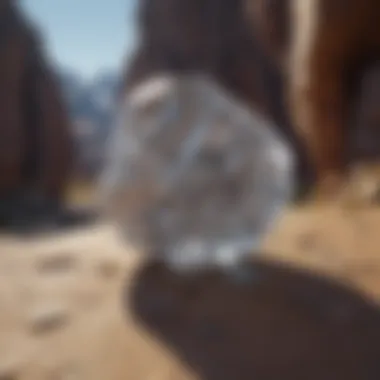Unveiling the Hidden World of Crystals in Rocks: A Comprehensive Guide


Rock and Fossil Identification
Understanding the world of crystals within rocks begins with mastering the identification of different types of rocks and fossils. Rocks such as igneous, sedimentary, and metamorphic each have distinct characteristics that hint at the potential presence of crystalline structures. Sedimentary rocks often contain fossils which can offer clues to the mineral composition within. By closely examining color, texture, and mineral content, collectors can start to spot signs of crystals within rocks. Utilizing tools like magnifying glasses, mineral guides, and UV lights can further assist in the identification process.
Collecting Tips and Techniques
For avid collectors seeking to uncover pristine crystals within rocks, adopting best practices is essential. Successful collections often stem from locating prime sites where geological processes have allowed for crystal growth. Researching geological maps and local mineral clubs can guide enthusiasts to fruitful collecting sites. Ensuring specimens are safely extracted involves using proper tools like chisels, hammers, and gloves to prevent damage to both the crystals and the surrounding rock.
Preservation and Display
Preserving and showcasing collected rocks and crystals is an art in itself. Techniques like cleaning with gentle brushes and water, avoiding harsh chemicals, and storing in airtight containers help maintain the integrity of the specimens. Proper storage methods include storing rocks away from direct sunlight and extreme temperatures to prevent deterioration. When it comes to displaying rocks, collectors can get creative by using stands, shadow boxes, or even arranging them in thematic dioramas to enhance aesthetic appeal.
Geological Insights
To truly appreciate the crystals hidden within rocks, it's crucial to delve into the geological insights that shape their formation. Understanding geological formations like faults, folds, and intrusions can provide context to the crystal growth process. Rocks and fossils hold historical significance, offering a window into Earth's past through their composition and age. By exploring notable discoveries in the field of geology, collectors can gain a deeper appreciation for the beauty and complexity of crystals within rocks.
Introduction
The world of geology is a fascinating realm filled with hidden treasures waiting to be discovered. Within the depths of rocks lie intricate crystalline structures that captivate the minds of collectors and enthusiasts alike. This article serves as a beacon, guiding readers through the intricate process of identifying these elusive crystals embedded within rocks. By unraveling the mysteries of crystal identification, this guide aims to unlock a newfound appreciation for the geological wonders that surround us.
Understanding the Fascination with Crystals
The Allure of Crystals in the World of Geology
Crystals hold a magnetic allure in the world of geology, offering a glimpse into the mesmerizing beauty of natural formations. Their precise geometries and stunning colors have entranced scientists and hobbyists for centuries. The allure of crystals lies in their ability to reflect light in unique ways, creating a spectacle that never fails to impress. In this article, we explore the enchanting appeal of crystals within geology, unravelling their significance in shaping our understanding of the Earth's geological history.
The Significance of Crystal Identification in Rock Collecting
Crystal identification plays a crucial role in rock collecting, elevating it from a hobby to a scientific pursuit. By deciphering the crystals present in rocks, collectors can unveil valuable insights into the rock's composition and origins. The significance of crystal identification lies in its ability to enrich the collecting experience, offering a deeper connection to the Earth's geological heritage. In this article, we delve into the profound importance of crystal identification in rock collecting, shedding light on its implications for enthusiasts seeking to delve deeper into the world of geology.


Purpose of the Article
Guiding Readers on How to Differentiate Crystals Within Rocks
A key aim of this article is to equip readers with the knowledge and practical skills needed to distinguish crystals within rocks effectively. By unraveling the complexities of crystal identification, this guide empowers readers to navigate the intricate world of geology with confidence. Readers will gain valuable insights into the characteristics and properties of various crystals, enhancing their ability to identify these hidden gems within rocky landscapes. Through a systematic approach, we aim to demystify the process of crystal differentiation, paving the way for enhanced exploration and discovery in the realm of geology.
Physical Characteristics of Crystals
In the realm of geology and mineralogy, understanding the physical characteristics of crystals plays a pivotal role in unraveling the secrets hidden within rocks. These characteristics serve as vital clues for enthusiasts and collectors, aiding in the identification and appreciation of the unique crystalline structures trapped within rocks. By delving into the specific elements that define these crystals, individuals can gain a deeper insight into the geological composition of rocks, providing a gateway to a world of wonder and exploration. Exploring the physical characteristics of crystals is not only a scientific endeavor but also a visually captivating experience that enriches the understanding of the Earth's natural formations.
Crystal Formation Processes
In-depth explanation of how crystals form within rocks
The process of crystal formation within rocks is a fascinating journey sculpted by nature's intricate mechanisms. Understanding the formation of crystals provides a profound insight into the geological history encapsulated within rocks. This aspect of crystal formation delves into the intricate interplay of minerals, pressure, and temperature that give rise to the exquisite crystalline structures observed in rocks. By comprehending the nuances of crystal formation, individuals can decipher the environmental conditions and timescales involved in shaping these geological treasures. This comprehensive explanation serves as a cornerstone for rock enthusiasts, offering a compelling narrative that connects them to the profound geological processes at play.
Distinctive Features of Crystals
Geometric shapes and structures of crystals
The geometric shapes and structures exhibited by crystals are mesmerizing patterns etched by nature, reflecting the inherent order and symmetry found in the mineral kingdom. These distinctive features not only showcase the precision of molecular arrangements within crystals but also highlight the aesthetic allure that captivates collectors and geology aficionados. By exploring the intricate geometries of crystals, individuals can appreciate the beauty of nature's designs while gaining insights into the underlying forces that govern crystal growth and morphology. This profound exploration of geometric shapes not only enhances the visual appeal of crystals within rocks but also offers a glimpse into the mathematical elegance embedded in the natural world.
Translucent and reflective properties of crystals
The translucent and reflective properties of crystals bestow upon them a captivating luster that sets them apart as unique geological entities. The interplay of light with crystal structures creates a dazzling display of colors and reflections, enchanting observers with its play of luminescence. These properties not only add to the visual appeal of crystals but also serve as distinctive markers for identifying different crystal types embedded within rocks. By understanding how light interacts with crystals, enthusiasts can unlock a world of visual wonders, appreciating the subtle nuances of transparency and reflectivity that characterize each crystal species. Exploring these properties enriches the appreciation of crystals within rocks, unraveling a kaleidoscope of optical splendors hidden beneath the surface.
Tools for Crystal Identification
In the realm of geology and mineralogy, the topic of Tools for Crystal Identification holds utmost importance. The meticulous process of identifying crystals within rocks requires precision and accuracy, making the selection of the right tools crucial. By utilizing specialized equipment and techniques, enthusiasts and collectors can delve deeper into the world of crystal formations. These tools not only aid in crystal recognition but also enhance the overall experience of rock examination and appreciation.
Magnifying Glass and Microscope


Utilizing magnification for detailed crystal examination
The utilization of magnification for detailed crystal examination is a cornerstone in crystal identification within rocks. This technique allows for a closer look at the intricate details and structures of crystals that are otherwise invisible to the naked eye. By magnifying the specimens, geology enthusiasts can observe the subtle geometric patterns, color variations, and internal characteristics of crystals, thereby enhancing their understanding and identification capabilities. The key characteristic of utilizing magnification lies in its ability to reveal micro-scale details that play a significant role in differentiating various types of crystals. This approach is highly beneficial for enthusiasts aiming to conduct in-depth analyses of crystal formations within rocks. One unique feature of utilizing magnification is its capacity to unveil hidden features that aid in precise crystal identification. While it offers unparalleled insights, the method also comes with challenges, such as the need for steady hands and proper calibration to avoid distortions in observation.
Determining crystal properties through hardness and streak tests
Another vital aspect of crystal identification is determining crystal properties through hardness and streak tests. These tests provide essential information regarding the physical characteristics of crystals, helping enthusiasts differentiate between similar-looking specimens. By conducting hardness tests using tools like a scratch plate and comparing the streak left by a crystal against different materials, collectors can assess the relative hardness and streak color, providing valuable clues for identification. The key characteristic of these tests is their ability to offer tangible data points that aid in the classification of crystals based on their unique properties. These tests are considered popular choices within the geology community due to their reliability and simplicity in determining crystal attributes. One standout feature of hardness and streak tests is their hands-on nature, which allows enthusiasts to engage directly with the specimens and draw conclusions based on empirical evidence. While these tests are valuable in crystal identification, they may have limitations in certain cases, such as when dealing with fragile or rare crystal specimens that are not suitable for scratching or streaking.
Observing Crystal Structure in Rocks
In the enchanting world of geology and mineralogy, observing crystal structure in rocks plays a pivotal role in unraveling the hidden treasures within. By closely examining the crystal formations embedded within rocks, enthusiasts can decipher the unique characteristics and properties of these natural wonders. This process not only enhances one's understanding of the geological makeup of rocks but also fosters a deeper appreciation for the intricate beauty of crystals.
Identifying Crystal Habit
Understanding the growth patterns of crystals within rocks
Delving into the realm of understanding the growth patterns of crystals within rocks sheds light on the intriguing processes that shape these geological marvels. By grasping how crystals develop and extend within rock formations, individuals can discern the various habits and tendencies exhibited by these crystalline structures. Understanding the growth patterns provides valuable insights into the environmental conditions and mineral compositions that influence crystal formation.
This facet of crystal identification serves as a fundamental aspect of the overarching goal of this article, which aims to equip readers with the skills to recognize and appreciate crystals within rocks effectively. The key characteristic of understanding growth patterns lies in its ability to unveil the unique journey each crystal undergoes during its formation, offering a glimpse into the geological history encapsulated within rocks. Exploring growth patterns enables enthusiasts to differentiate between various crystal habits, enhancing their proficiency in identifying different types of crystals within rocks.
Color and Transparency Clues
How color and transparency indicate crystal presence
The examination of color and transparency within rocks serves as a crucial indicator of the presence of crystalline structures. Colors ranging from vibrant hues to subtle tones provide valuable clues regarding the mineral content and composition of crystals embedded in rocks. Similarly, transparency levels offer insights into the purity and quality of crystals, guiding collectors and geologists in determining the authenticity and value of specimens.
This aspect significantly contributes to the overarching theme of this article by highlighting the significance of subtle visual cues in identifying crystals within rocks. The key characteristic of evaluating color and transparency lies in its ability to swiftly identify potential crystal formations without intricate testing procedures. By leveraging color and transparency clues, enthusiasts can streamline their crystal recognition process, enabling efficient identification of crystals based on visual distinctions.
Common Types of Crystals in Rocks
In the realm of geology and mineralogy, understanding common types of crystals in rocks holds significant importance. The ability to recognize and differentiate between various crystals is a skill that caters directly to the curiosity and passion of rock and fossil collectors. By shedding light on the distinguishing features and characteristics of different crystals commonly found in rocks, this article enhances the expertise of enthusiasts in identifying these exquisite formations.


Moving to specific types, we delve into two prevalent varieties that hold a special place in the world of crystal identification.
Quartz Crystals
Characteristics and Formations of Quartz Crystals
Quartz crystals are renowned for their unique characteristics and formations, making them a standout choice for exploration within this field. The impeccable hexagonal structure of quartz crystals, along with their transparent nature, sets them apart as a prime specimen for study and admiration. The inherent ability of quartz crystals to form in diverse environments and conditions adds to their appeal, providing a fascinating insight into the geological processes that shape our natural world.
Exploring quartz crystals within the context of this article not only broadens the understanding of crystal formations but also introduces enthusiasts to a cornerstone of crystal identification. The versatility and prevalence of quartz crystals make them not only a beneficial but almost essential inclusion in any discourse concerning crystals hidden within rocks.
Calcite and Feldspar Crystals
Distinguishing Features of Calcite and Feldspar Crystals
As we turn our attention to calcite and feldspar crystals, we uncover a realm of intricate features that contribute significantly to our overall comprehension of crystal formations within rocks. The distinct properties of calcite and feldspar crystals, such as their unique cleavage patterns and varying colors, offer a fascinating playground for collectors and researchers alike.
Exploring the distinguishing features of calcite and feldspar crystals enriches our understanding of the diverse manifestations that crystals can take within rocks. By focusing on these particular crystals, we gain a deeper insight into the complexities and nuances of crystal identification, paving the way for enhanced recognition skills and a more profound appreciation of the geological treasures hidden within rocks.
Conclusion
As we conclude our deep dive into the intricate world of identifying crystals within rocks, it becomes evident that this skill holds immense significance for rock and fossil collectors, mineral enthusiasts, and geologists alike. The ability to discern crystalline structures hidden within rocks opens up a whole new realm of exploration and understanding in the geological and mineralogical realms. By mastering the art of identifying crystals, collectors can enhance their appreciation for the natural beauty and complexity found within rocks.
Furthermore, honing crystal recognition skills allows enthusiasts to differentiate between various types of crystals, such as quartz, calcite, and feldspar, enabling them to build a more comprehensive collection and deepen their knowledge of mineral formations. Understanding the distinctive features and properties of crystals within rocks not only adds value to a collection but also aids in scientific research and geological studies.
Enhancing Your Crystal Recognition Skills
Key takeaways for identifying crystals within rocks
Delving into the realm of [Key takeaways for identifying crystals within rocks], we uncover a vital aspect of crystal identification that underpins the core essence of our exploration. The key takeaway focuses on equipping readers with the essential knowledge and skills needed to confidently spot and differentiate crystals within rocks.
A crucial characteristic of [Key takeaways for identifying crystals within rocks] lies in its ability to provide a systematic approach to crystal identification, breaking down complex processes into manageable steps. This structured framework not only simplifies the recognition process but also empowers enthusiasts to tackle crystal identification with precision and accuracy.
The unique feature of [Key takeaways for identifying crystals within rocks] lies in its emphasis on practical application. By offering practical tips, visual aids, and real-world examples, this aspect of our discussion equips readers with hands-on tools to sharpen their crystal recognition skills effectively. As a beneficial choice for this article, [Key takeaways for identifying crystals within rocks] serves as a foundational building block for readers, laying the groundwork for a deeper exploration into the fascinating world of crystals hidden within rocks.
Moreover, the advantage of incorporating [Key takeaways for identifying crystals within rocks] into our narrative lies in its ability to enhance reader engagement and retention. Through clear explanations, illustrative examples, and actionable insights, this section not only educates but also captivates the audience, fostering a lasting interest in the art of crystal identification within the geological landscape.
In summary, [Key takeaways for identifying crystals within rocks] functions as a pivotal component in our guide, enriching the reader's understanding, and practical skills in identifying crystals within rocks to foster a more enriching and rewarding experience in the world of geology and mineralogy.







